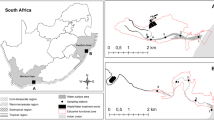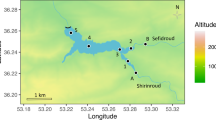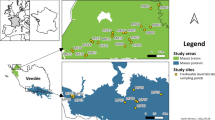Abstract
The Living Docks restoration program was implemented in the Indian River Lagoon (IRL), Florida, with the goal of affixing oyster restoration mats to dock pilings to promote the growth of filter feeding benthic organisms which can help improve local water quality. However, the relationship between IRL water quality parameters and the presence of filter feeders on the mats is not entirely clear. This study investigates the presence of benthic organisms on eight Living Docks which were deployed throughout the central part of the IRL. Environmental factors (e.g., water salinity, turbidity, pH, and temperature) were collected from the closest available water station to each dock. The main goal was to identify the presence and overall change in percent cover of specific benthic organism(s), those which are known filter feeders, in relationship to environmental parameters. Among functional groups which were identified, barnacles, biofilms, encrusting bryozoans (EBs), oysters, and sponges demonstrated significantly higher cover than the others. Barnacles were higher in abundance at specific dock locations and an increased water pH (up to 8.1), turbidity, and temperature. EB presence was positively impacted by salinity but did not respond to changes in turbidity or temperature within the measured ranges. Oysters were not observed to be impacted by any of the factors within measured ranges. Sponges had sustained abundance in half of the docks in this study. However, they did not respond to any of the environmental factors within measured ranges in different seasons. Results from this study can help target future Living Dock locations which will provide the best environment for the recruitment of filter feeding organisms.







Similar content being viewed by others
Data Availability
The data that support the findings of this study are not openly available and are available from the authors upon reasonable request.
References
Aggrey-Fynn, J., Galyuon, I., Aheto, D. W., & Okyere, I. (2011). Assessment of the environmental conditions and benthic macroinvertebrate communities in two coastal lagoons in Ghana. Annals of Biological Research, 2(5), 413–424.
Ali, I., Singh, P., Aboul-Enein, H. Y., & Sharma, B. (2009). Chiral analysis of ibuprofen residues in water and sediment. Analytical Letters, 42(12), 1747–1760.
Atwood, R. L., & Grizzle, R. E. (2020). Eastern oyster recruitment patterns on and near natural reefs: Implications for the design of oyster reef restoration projects. Journal of Shellfish Research, 39(2), 283–289. https://doi.org/10.2983/035.039.0209
Barbier, E. B., Hacker, S. D., Kennedy, C., Koch, E. W., Stier, A. C., & Silliman, B. R. (2011). The value of estuarine and coastal ecosystem services. Ecological Monographs, 81(2), 169–193.
Barile, P. J. (2018). Widespread sewage pollution of the Indian River Lagoon system, Florida (USA) resolved by spatial analyses of macroalgal biogeochemistry. Marine Pollution Bulletin, 128, 557–574.
Basheer, A. A. (2018a). Chemical chiral pollution: Impact on the society and science and need of the regulations in the 21st century. Chirality, 30(4), 402–406.
Basheer, A. A. (2018b). New generation nano-adsorbents for the removal of emerging contaminants in water. Journal of Molecular Liquids, 261, 583–593.
Bulleri, F., & Chapman, M. G. (2010). The introduction of coastal infrastructure as a driver of change in marine environments. Journal of Applied Ecology, 47(1), 26–35.
Chicharo, L. M. Z., & Chicharo, M. A. (2000). Short-term fluctuations in bivalve larvae compared with some environmental factors in a coastal lagoon (South Portugal). Scientia Marina, 64(4), 413–420.
Conover, W. J. (1999). Practical nonparametric statistics (Vol. 350). John Wiley & Sons.
Dickinson, G. H., Ivanina, A. V., Matoo, O. B., Pörtner, H. O., Lannig, G., Bock, C., Beniash, E., & Sokolova, I. M. (2012). Interactive effects of salinity and elevated CO2 levels on juvenile eastern oysters, Crassostrea virginica. Journal of Experimental Biology, 215(1), 29–43.
Douma, J. C., & Weedon, J. T. (2019). Analyzing continuous proportions in ecology and evolution: A practical introduction to beta and Dirichlet regression. Methods in Ecology and Evolution, 10(9), 1412–1430.
Ehrich, M. K., & Harris, L. A. (2015). A review of existing oyster filtration rates models. Ecological Modelling, 297, 201–212.
Eskelson, B. N., Madsen, L., Hagar, J. C., & Temesgen, H. (2011). Estimating riparian understory vegetation cover with beta regression and copula models. Forest Science, 57(3), 212–221. https://doi.org/10.1093/forestscience/57.3.212
Ferrari, S., & Cribari-Neto, F. (2004). Beta regression for modelling rates and proportions. Journal of Applied Statistics, 31(7), 799–815.
Galtsoff, P. S. (1964). The American oyster Crassostrea virginica Gmelin. US Fisheries Bulletin, 64, 1e480.
Garvis, S., Sacks, P. E., & Walters, L. J. (2015). Formation, movement, and restoration of dead intertidal oyster reefs in Canaveral National Seashore and Mosquito Lagoon, Florida. Journal of Shellfish Research, 34(2), 251–258.
Gattuso, J. P., Magnan, A., Billé, R., Cheung, W. W., Howes, E. L., Joos, F., Allemand, D., Bopp, L., Cooley, S. R., Eakin, C. M., & Hoegh-Guldberg, O. (2015). Contrasting futures for ocean and society from different anthropogenic CO2 emissions scenarios. Science, 349(6243), aac4722.
Geissinger, E. A., Khoo, C. L., Richmond, I. C., Faulkner, S. J., & Schneider, D. C. (2022). A case for beta regression in the natural sciences. https://doi.org/10.1002/ecs2.3940
Gilligan, M., Hunsucker, K., Rech, S., Sharma, A., Beltran, R., White, R. T., & Weaver, R. (2022). Assessing the biological performance of living docks – A citizen science initiative to improve coastal water quality through benthic recruitment within the Indian River Lagoon, Florida. Journal of Marine Science and Engineering, 10, 823.
Hanisak, M. D., & De Freese, D. E. (2020). Reassessing the biodiversity of the Indian River Lagoon. Florida Scientist, 84(2/3), 62–68.
Harbour, R. P., Leitner, A. B., Ruehlemann, C., Vink, A., & Sweetman, A. K. (2020) Benthic and demersal scavenger biodiversity in the Eastern End of the Clarion-Clipperton Zone – An area marked for polymetallic nodule mining, Frontiers in Marine Science. https://doi.org/10.3389/fmars.2020.00458
Howie, A. H., & Bishop, M. J. (2021). Contemporary oyster reef restoration: Responding to a changing world. Frontiers in Ecology and Evolution, 9, 689915.
Hunsucker, K., Melnikov, A., Gilligan, M., Gardner, H., Erdogan, C., Weaver, R., & Swain, G. (2021). Catholically protected steel as an alternative to plastic for oyster restoration mats. Ecological Engineering, 164: https://doi.org/10.1016/j.ecoleng.2021.106210
Indian River Lagoon (2011) Consortium (IRL2011C). Super bloom report: evaluating effects and possible causes with available data. St. Johns River Water Management District, Bureau of Environmental Sciences, Estuaries Section, Palatka. 2015.
Indian River Lagoon: Environmental literacy: Blog, Nuttle, B. (2016). https://ian.umces.edu/blog/indian-river-lagoonenvironmental-literacy/
Johnson, R. K., Wiederholm, T., & Rosenberg, D. M. (1993). Swedish university of agricultural sciences, department of environmental assessment. Freshwater biomonitoring using individual organisms, populations, and species assemblages of benthic macroinvertebrates.
Layman, C. A., Jud, Z. R., Archer, S. K., & Riera, D. (2014). Provision of ecosystem services by human-made structures in a highly impacted estuary. Environmental Research Letters, 9(4), 044009.
Lotze, H. K., Lenihan, H. S., Bourque, B. J., Bradbury, R. H., Cooke, R. G., Kay, M. C., Jackson, J. B., et al. (2006). Depletion, degradation, and recovery potential of estuaries and coastal seas. Science, 312(5781), 1806–1809.
Dünder, E., & Cengiz, M. A. (2020). Model selection in beta regression analysis using several information criteria and heuristic optimization. Journal of New Theory, 33, 76–84.
Parkinson, R. W., Seidel, V., Henderson, C., & De Freese, D. (2020). Risks to Indian River Lagoon biodiversity caused by climate change. Florida Scientist, 84(2/3), 232–244.
Pruett, J. L., Pandelides, A. F., Willett, K. L., & Gochfeld, D. J. (2021). Effects of flood-associated stressors on growth and survival of early life stage oysters (Crassostrea virginica). Journal of Experimental Marine Biology and Ecology, 544, 151615.
Przeslawski, R., Ahyong, S., Byrne, M., Woerheide, G., & Hutchings, P. A. T. (2008). Beyond corals and fish: The effects of climate change on noncoral benthic invertebrates of tropical reefs. https://doi.org/10.1111/j.1365-2486.2008.01693.x
Rech, S. L. (2022). Modeling settlement and filtration of the Indian River Lagoon Benthic community, with an emphasis on Living Dock restoration mats (Master’s Thesis).
Taniguchi, H., & Tokeshi, M. (2004). Effects of habitat complexity on benthic assemblages in a variable environment. https://doi.org/10.1111/j.1365-2427.2004.01257.x
Trefry, J. H., & Fox, A. L. (2021). Extreme runoff of chemical species of nitrogen and phosphorus threatens a Florida Barrier Island Lagoon. Frontiers in Marine Science. https://doi.org/10.3389/fmars.2021.752945
U.S. Environmental Protection Agency. (2009). National water program research strategy, 2009–2014. https://www.epa.gov/sites/default/files/2015-04/documents/strategy-report-2009.pdf
Vargha, A., & Delaney, H. D. (1998). The Kruskal-Wallis test and stochastic homogeneity. Journal of Educational and Behavioral Statistics, 23, 170–192.
Wassick, A., Hunsucker, K. Z., & Swain, G. (2022). A baseline survey to document the distribution and abundance of native and non-native barnacle species in Port Canaveral, Florida. BioInvasions Record, 11(3).
Weaver, R. J., Hunsucker, K. Z., et al. (2018). The Living Dock: A study of benthic recruitment to oyster substrates affixed to docks in the Indian River Lagoon. Marine Technology Sociey Journal, 52(4), 7–18.
Wilcoxon, F. (1945). Individual comparisons by ranking methods. Biometrics Bulletin., 1(6), 80–83. https://doi.org/10.2307/3001968
Wilson, C., Scotto, L., Scarpa, J., Volety, A., Laramore, S., & Haunert, D. (2005). Survey of water quality, oyster reproduction and oyster health status in the St. Lucie Estuary. Journal of Shellfish Research, 24(1), 157–165.
Worm, B., Barbier, E. B., Beaumont, N., Duffy, J. E., Folke, C., Halpern, B. S., Watson, R., et al. (2006). Impacts of biodiversity loss on ocean ecosystem services. Science, 314(5800), 787–790.
Yellareddygari, S. K., Pasche, J. S., Taylor, R. J., Hua, S., & Gudmestad, N. C. (2016). Beta regression model for predicting the development of pink rot in potato tubers during storage. https://doi.org/10.1094/PDIS-06-15-0696-RE
Acknowledgements
The data analysis and modeling were conducted as part of REU (Research Experiences for Undergraduates) program funded by NSF (Grant 1950768). The Living Docks program and portions of the data collection were funded by the Indian River Research Institute at the Florida Institute of Technology.
Author information
Authors and Affiliations
Corresponding author
Ethics declarations
Conflict of Interest
The authors declare no competing interests.
Additional information
Publisher's Note
Springer Nature remains neutral with regard to jurisdictional claims in published maps and institutional affiliations.
Rights and permissions
Springer Nature or its licensor (e.g. a society or other partner) holds exclusive rights to this article under a publishing agreement with the author(s) or other rightsholder(s); author self-archiving of the accepted manuscript version of this article is solely governed by the terms of such publishing agreement and applicable law.
About this article
Cite this article
Despeignes, A., Sharma, A., Beltran, R. et al. The Impact of Benthic Organisms to Improve Water Quality in the Indian River Lagoon, Florida. Water Air Soil Pollut 234, 546 (2023). https://doi.org/10.1007/s11270-023-06528-w
Received:
Accepted:
Published:
DOI: https://doi.org/10.1007/s11270-023-06528-w














